When orphaned Daisy deer first came to us, we researched whether we should put a blaze orange collar on her or not. It seemed a good idea since it could protect her somewhat when she was finally released to the wild. Hunters would be aware she had been raised by humans – it’s a universal understanding that harvesting a wild animal with an orange collar would be off limits. The reflective orange would make Daisy visible to vehicles when she crossed roads after dark – and we do have a couple of well-traveled roads nearby that the deer tend to cross. And lastly, she would be easily identified by neighbors. When Daisy was young, people in the neighborhood often reported where they had seen her, and most everyone was happy if she visited their property. For the five years Daisy has been in a blaze orange collar, it has served her well.
As Daisy grew, I got used to making new collars every few months. Early on, we bought collars with snaps and then affixed a reflective strip on them. Then, a friend in Texas who raised an orphaned deer many years before we acquired Daisy, showed me how she made collars for her deer with fabric, reflective tape, and Velcro. That way, should Daisy get hung up on something – a branch or a fence – she could tear away from the collar – much easier than the snap collars we had been using. Her latest design in fashioning a collar was to make it from orange Duck Tape, with a reflective strip down the middle and a Velcro closure. Copying her design, FD and I found these collars stood up well in the tough Oklahoma weather, yet were still safe for Daisy to tear off if she got hung up on something.
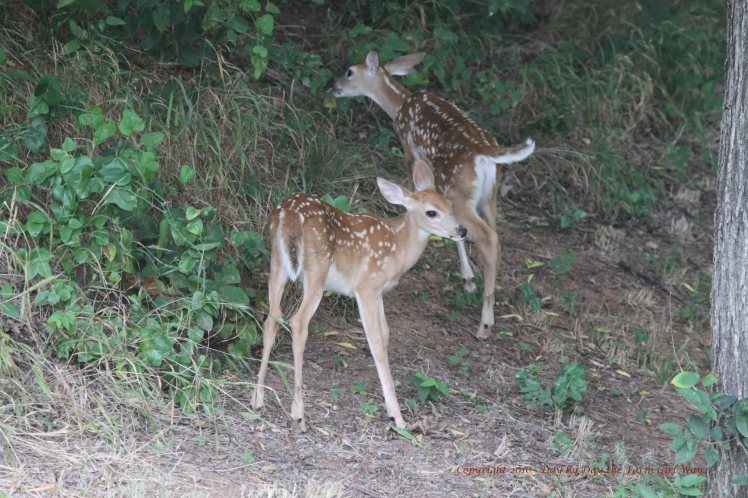
I had gone to a lot of trouble putting together her last couple of collars. I reinforced the area where the tape met the Velcro, as there always seemed to be a problem with that seam tearing in a short time. Still, the first reinforced collar somehow came off and was lost just a few weeks after we put it on her. I could not say exactly what happened with it, since we have never found it, but Daisy seemed quite pleased being collar-free for a time (like she usually was when this happened) and gave us a lot of trouble getting another one on her. I couldn’t blame her for dodging us when we came at her with a new collar. I never liked anything around my neck either. Even necklaces tend to bug me when I wear them on an evening out.
But we did finally get the second collar on her, and it held together quite well during this year’s spring rains and the early summer heat. There were the usual barbed wire fence nicks in it, and a slight peeling of the adhesive from the Velcro due to the rain and heat, but all in all it was holding up well. In fact, she was still wearing it after she birthed her twins this year in early June. I marveled at how evident that collar made her at a distance. Daisy and her twins would blend in with the woodlands, but that orange could always be seen at the slightest glance. I even noticed Daisy’s twins seemed curious about their mother’s adornment, and often sniffed or licked it.
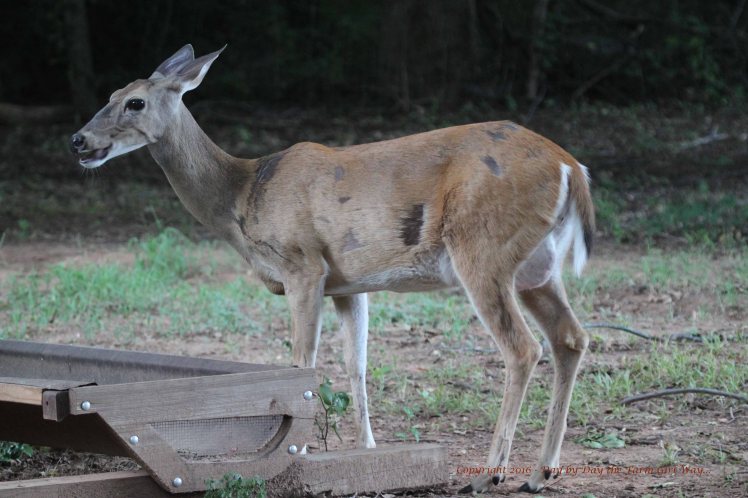
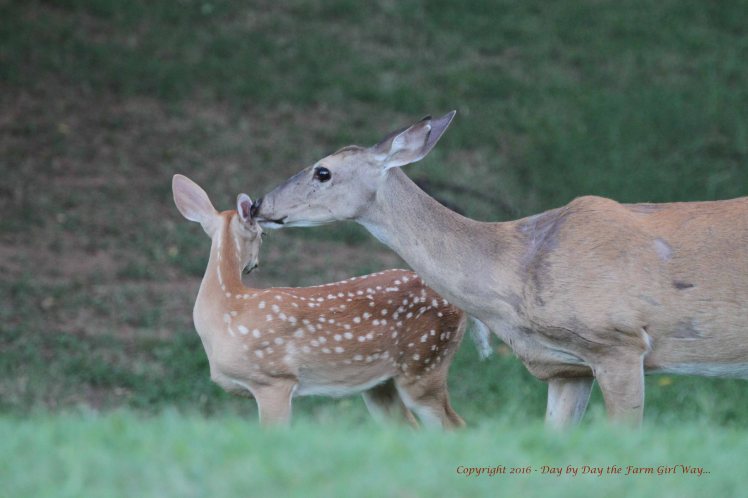
Then one day in mid-July, Daisy showed up without her collar. On meeting her down at the bottom of the slope, FD could immediately see that, besides a missing collar, Daisy had many dull claw marks around her neck, along with a wide band of hair around her neck and shoulders that was missing or rubbed off, several patches of bruising and more hair missing on her body, as well as having scratched up legs. With all this, it was obvious Daisy had gone to battle to protect a fawn – perhaps with a wild dog or a coyote, that may have latched onto Daisy’s collar during the fight, keeping her from breaking free. This wasn’t the first time we had seen this when Daisy was raising fawns. Her very first buck had been lost to a bobcat, which Daisy fought mightily, even becoming injured badly herself. After thinking the collar may have provided the predator a “handhold” that kept Daisy from adequately protecting herself and her fawn, FD and I decided it was time to let her be collar-free for good.

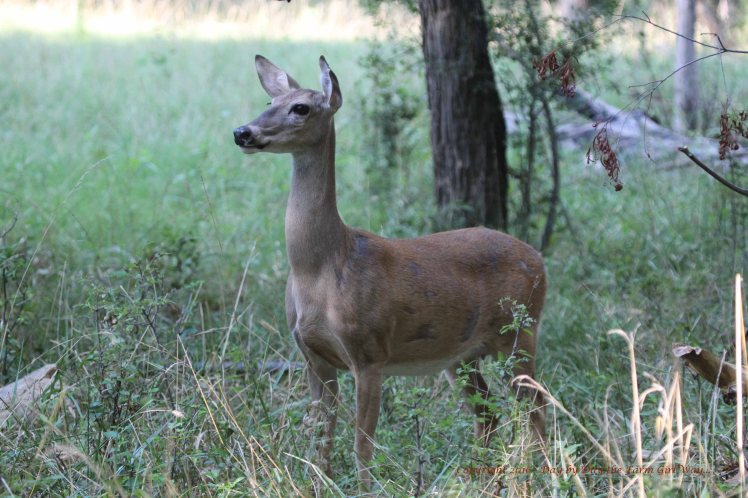

This has caused us to wonder about Emma and Ronnie deer and how long to keep them in a collar as well. FD and I seem to agree that Ronnie might wear one his first year as a fawn. But as he becomes a yearling and develops antlers, it may not be safe. His world will be difficult as a buck with sparring and fighting during the rut season and a collar could be a disadvantage in battle. As for Emma, we still believe it is a good idea to keep a collar on her for a time as she explores her territory, and becomes acclimated to living as a wild deer. Had it not been for her identifying orange collar, Daisy may not have been returned to us when, as a yearling, she decided to explore the backyards of a neighborhood a half mile up the river channel. These types of decisions are never easy and, ultimately, we just want the best for our wild critters. And now, it feels right to give Daisy this final freedom… after all, she has earned it.
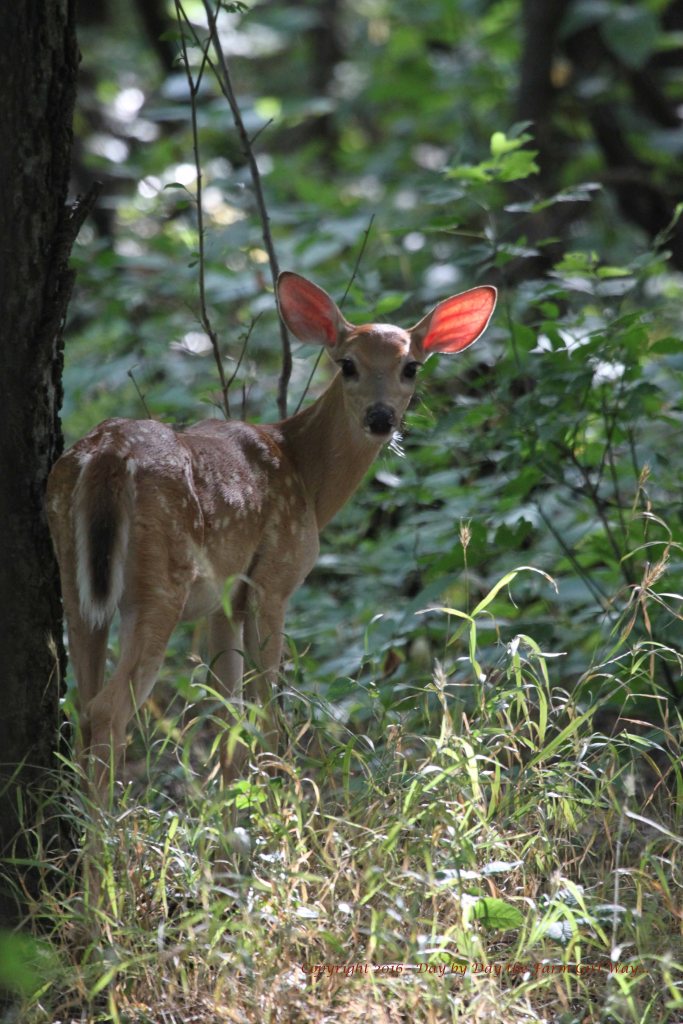
© 2016 Day by Day the Farm Girl Way…
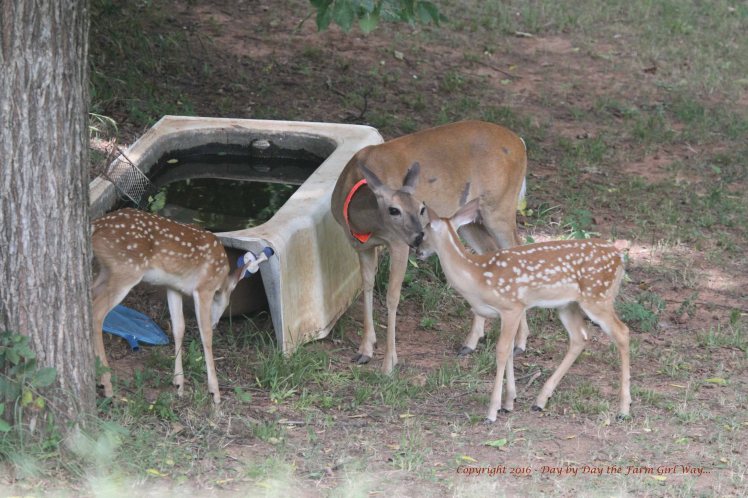
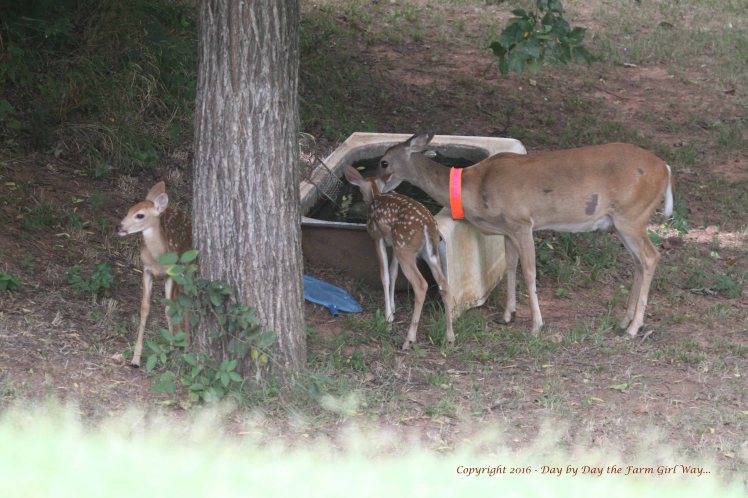
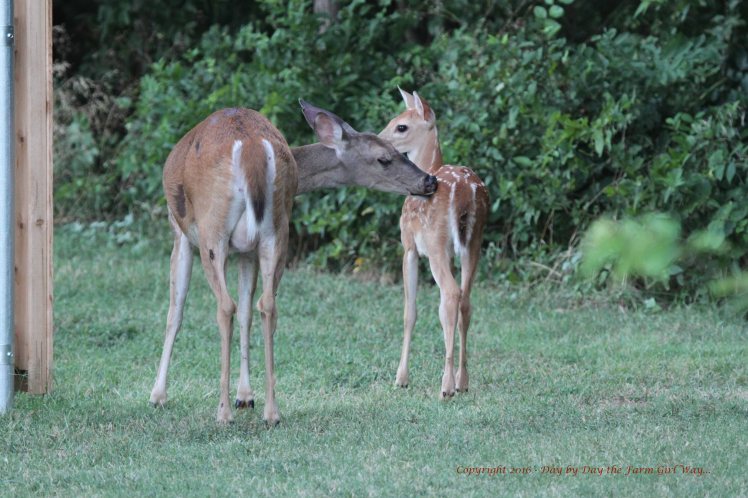
Awww. Your a dear, deer Mom, Lori. These decisions are difficult. I had a little chuckle as I pictured the fawns nudging and licking Daisy’s orange collar–maybe they wondered why they didn’t have one and they wanted one too! I sure hope everyone survives to a nice old age. xx
LikeLike
I hope so too, Ardys. Daisy is five this year and looks so mature. I have often wondered if other deer noticed Daisy’s collar. Emma and Ronnie do not seem to mind theirs, and we have already had to make them larger ones – they’re growing so fast! I dread the winter months until we can free Emma and Ronnie. January 15th marks the end of hunting season. We will free them on the morning of the 16th. They’ll be just over seven months old. I will have to get video of that event!
LikeLiked by 2 people
It is indeed a dilemma – good luck to our Daisy Deer.. c
LikeLike
Thank you, C. I thought I might have trouble spotting Daisy, but I find her easily In the woods without her collar… Must be that “splatter” vision I have! 🙂
LikeLike
At first reading, and with the use of the quotation marks, I imagined that “splatter vision” was something that you or Celi had coined. But curiosity won out and I looked it up and to find that is a real term for using your peripheral vision! I liked this PDF on the subject best: https://www.princeton.edu/~oa/nature/naturobs.pdf
I am a teaspoon smarter this morning. 🙂
Thanks!
LikeLike
I know the teacher in you never stops!! Ha ha! Lynda, you are correct and that is an excellent link. I understand for some people it takes time to acquire splatter vision, but it came easily for me. I also use this technique when star gazing with a friend who has a large, portable telescope. To me, it makes everything quite clear and easy to see.
LikeLiked by 1 person
This might be a stupid question, but I don’t intend it to be: could you spray paint a “collar” onto her? Or, if the spray sound would scare Daisy, perhaps a brush with paint?
LikeLike
No question is ever stupid… and your question is a good one. The only danger I see with spray paint would be since deer mutual groom each other, I would worry about it being toxic to the deer who might groom on Daisy. Generally two deer will groom the neck and head areas on each other – places they cannot reach on themselves. Also, I wouldn’t think paint would last very long. But if there was a non-toxic paint that could be used, it would certainly be an idea! Thanks for asking!
LikeLiked by 1 person
That’s so interesting how you made different decisions for Emma and Ronnie because of their genders. I think your thought process makes a lot of sense. Daisy and her family are very lucky to have you watching over them. 🙂
LikeLike
Yes, Daisy and her kids are lucky we look out for them. FD mentioned Daisy going across town following the river when she was a yearling – that was not a good situation at all. Thankfully, because she had the collar on and neighbors knew her, they were able to tell the police that she was ours and they brought her here (after tranquilizing her unnecessarily). That collar saved her – or the police may have shot her for roaming into a neighborhood!
LikeLike
To collar or not to collar- that is the question. I would be miserable having to make that decision. I hope that ya’lls assumption is correct- that the collar is more of a hindrance than a help. I hope she does not become a target. Maybe you can put one back on in hunting season? Or not.
LikeLike
Yvonne, that’s a good question and one we are still mulling over. If we are able to get one on her we might do that during hunting season only.
LikeLiked by 1 person
I was thinking the same thing. Hunting season seems to require a collar to protect her. Otherwise I fear for Daisy.
LikeLike
I have a feeling we will try to put one on her. Hunting season here is October 1st through January 15th. Emma and Ronnie will be released January 16th.
LikeLike
I hope that y0u can, collar Daisy during hunting season.
LikeLike
I can’t tell you how emotionally torn I feel by these stories. I read The Yearling when I was quite young, and I think that book scarred me for life. I loved it, but I learned from it that living in the wild and living with the wild is full of pain and loss and, as you are describing, difficult decisions. I feel the same churn in my stomach reading this as I did finishing the last pages of that book many years ago. Your instincts are good and wise, and I know you are doing what is right after long meditation, but still, it is hard, isn’t it? Best of luck to all of you.
LikeLike
What a lovely comment and thank you for wishing us well. Your comment made my day actually! Your observations are exactly how it feels for us. After many years of animal rehabilitation and living so near the woodlands, we have experienced our share of heartache and disappointment. But Daisy has taught us much about acceptance and resilience. Wild things have been my greatest teacher about life and death.
LikeLiked by 1 person
I envy you that teacher, which is why I love your blog!
LikeLike
I envy you that teacher, which is why I love your blog. You pass your learnings along, and the stories are always riveting.
LikeLike
Well, you just keep on making my day!! Thank you, Charlotte. 🙂
LikeLike
What a beauty!
LikeLike
Thank you, Mike!
LikeLike
Animal attacks?!? Not a happy thought. I understand your reasoning for abandoning the collar. AND, that last photo is a stunner, Lori!
LikeLike
Aw, thank you Lynda. This little buck of Daisy’s is not afraid of us. We haven’t been able to get very close but he seems comfortable to allow me to tag along behind with the camera. He’s quite independent too! When Daisy comes to me for some attention, he makes a few whining noises, then takes off! Also, if he tires of waiting on Daisy while she eats feed, he just moves on. He seems to be in charge! Ha ha!
LikeLiked by 1 person
I’m curious – how do you recognize Daisy among other deer? Do they look different enough to tell them apart or is it just her trusting behavior?
LikeLike
Good question! At a distance we don’t always know who is who, but we do know several of the local deer by sight. The eyes are what I look at mostly, but there are other physical signs. Daisy is a small deer, and she has a slight split in her ear that she acquired in the bobcat fight years ago. Her hooves are a bit different too (often we can tell her tracks apart from other deer). Even mannerisms can be a way of telling deer apart. Scarlet doe has a specific walk and she is a BIG deer. After one sees them enough and observes them a good bit it is easy to tell them apart.
LikeLike
Tough decisions, but you are weighing things out in an intelligent (and compassionate) way. It’s rough, especially in this day and age, to be a deer (and keep alive)… so my heart goes out to them. ( I sure don’t like to wear neck ties; fortunately, not yet anyway, there are no predators lunging at me.)
LikeLiked by 1 person
Ha ha ha!! Oh Tom, that gave me a visual… having to wear a tie to ward off predators! We may still put a collar on Daisy during hunting season, but she already runs when we try put one on her. It usually takes me detaining her while FD tries to slip it on. We will just see how it goes.
LikeLiked by 1 person
Good luck! (Those damn hunters! My brother-in-law has a family room full of taxidermy animals that he has killed… and a whole section of a deer head family. I avoid the in-laws like the plague! Being with them is like spending time with Neanderthals!)
LikeLike
When I lived in Nebraska I visited a home where the husband had all of the walls FILLED with trophies from hunts all over the world… and every mammal, bird and reptile you could think of that was legal to kill. His wife told me they had a woman come in on a monthly basis who specialized in taxidermy and care of these trophies (dusting mostly). They had special lighting throughout the house to protect the displays. It was my first exposure to the “sport” of hunting. It made me sad.
LikeLiked by 1 person
My hunting brother-in-law claims that he loves nature! I hope that he never gets fond of me!
LikeLike
What a beautifully-written post, as usual. We’ve had several issues with collars even with our two dogs and keep changing – or removing them altogether – at times. Collars, of course, give the pet – deer cats or dogs – an identity, don’t they?
LikeLike
I do not keep collars on my house dogs. It’s silly. And since we are not in city limits, they are not required. Daisy never did like the collars but they have protected her in many ways. The danger came from being a defensive mother protecting her babies. I am glad she survived this fight with just a few scrapes, bruises and missing hair. I still think the design we’ve used with the duck tape, reflective strip, and velcro closure has served her well.
LikeLiked by 1 person
That’s right. However, we are in city limits and need collars on dogs. Tyson’s collar helped identify him when he went missing a few years ago 🙂
LikeLike
They do serve a good purpose on that note! Tyson is one lucky fella!! 🙂
LikeLiked by 1 person